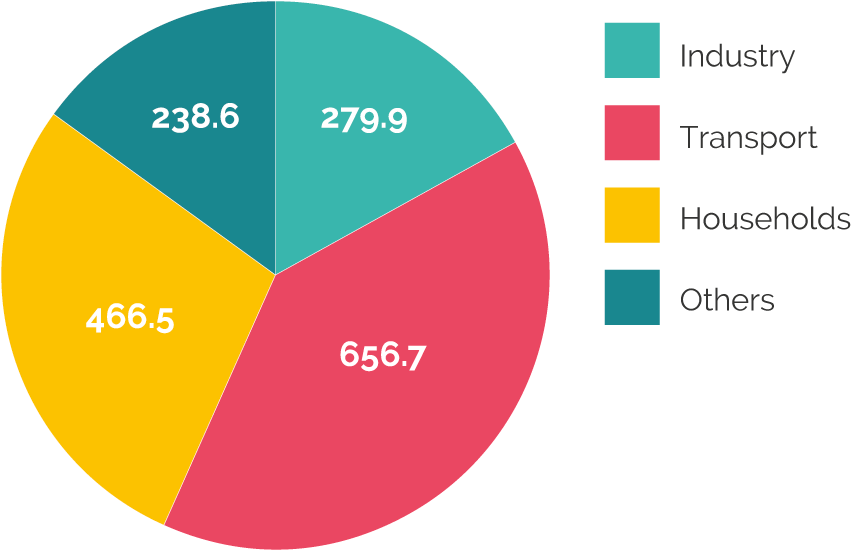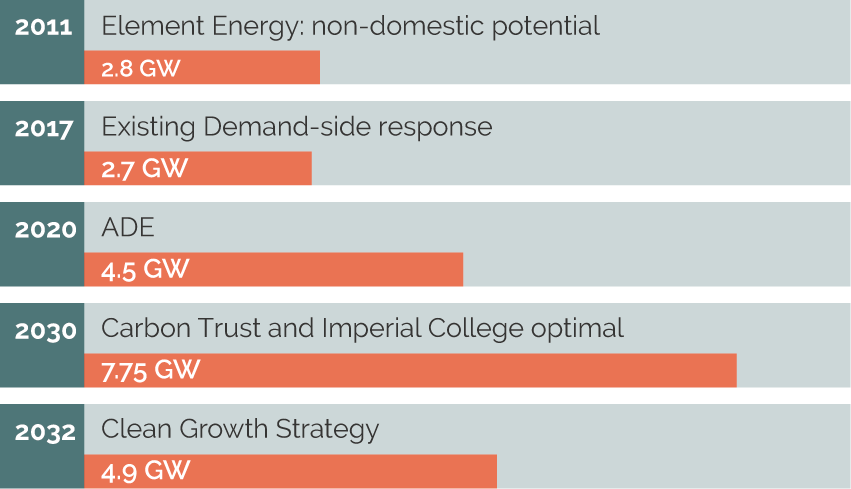Editors: Nick Eyre & Gavin Killip
Summary
The Centre for Research into Energy Demand Solutions (CREDS) works with researchers, businesses and policymakers to support the transition to a low-carbon energy system. This summary provides a quick look at our first major report, which takes the Government’s most recent statement on energy transition, the Clean Growth Strategy (CGS), as a starting point and draws on current knowledge from the UK energy demand research community.
Building on the comprehensive, quantitative analysis by the Committee on Climate Change (CCC), we agree that major improvements in energy productivity in businesses, transport and homes are crucial to achieving the CGS goal of accelerating the pace of clean growth: this requires attention to the technical, social and institutional factors that drive energy demand. A much stronger focus on energy demand solutions is needed to address the greater action implied by a net-zero carbon target, and we set out recommendations on the policy changes required to deliver the energy-use related goals of the CGS.
A much stronger focus on energy demand solutions is needed to achieve a net-zero carbon economy.”
Recommendations
The complexity of energy demand means there is no ‘silver bullet’ solution or policy: a range of policy instruments is required to meet energy policy goals. These involve many sectors, institutions and stakeholders, with a variety of different timescales for action. The main report lists a large number of recommendations which fall under these broad headings:
Prioritise energy demand solutions
The energy transition needs to be led by government and there needs a concerted effort to engage, enthuse and empower stakeholders across business and civil society to deliver.”
Energy demand change can support all the key goals of energy policy – security, affordability and sustainability – with more synergies and fewer trade-offs than only finding new ways to generate extra energy. For this reason, treating demand reduction as ‘the first fuel’ is already the policy of the International Energy Agency (IEA) and the European Union. Demand-side solutions also form a key part of implementing zero carbon sustainable supply, through using zero carbon fuels and enabling greater use of variable renewables. In UK energy policy, there has been a tendency to focus on energy supply options rather than a systemic approach. We recommend that this is reversed, and that demand-side solutions are given at least equal weight.
Compared to increased energy supply, reduced energy demand together with improved energy efficiency, greater flexibility and decarbonised fuels has a much wider range of benefits, notably for health and employment.”
Consider and promote the many wider benefits of demand-side solutions
Addressing the demand for energy is more likely to promote sustainable development, compared to simply increasing the supply of energy. Reduced demand, improved energy efficiency, greater flexibility and decarbonised fuels have a broad range of benefits, notably for health and employment. Recognising these wider benefits is more likely to motivate action. We recommend that these many benefits of demand-side solutions are considered in developing and promoting policy.

Image data
Industry 279.9 TWh in 2017; Transport 656.7 TWh; Households 466.5 TWh; Others 238.6 TWh.
Scale up policies that work
UK energy demand policy has featured numerous policy changes in the last decade. In some cases, such as the Carbon Emissions Reduction Target, the Carbon Reduction Commitment and the proposed Zero Carbon Homes standard, policy instruments that were well-designed and effective have been modified, or much reduced in scale. This has significantly reduced the effectiveness of UK energy policy and implementation of demand-side solutions. We recommend greater consistency in demand-side policymaking and, in particular, scaling up policies that have been shown to work.
Develop long-term plans and support for demand- side innovation
There has been a tendency in policymaking to see the demand- side as having the potential to provide quick wins, but not to have a fundamental role in the energy transition. Our analysis indicates that this is unhelpful. Energy demand reduction, flexibility and decarbonisation will need to play a critical role and this should be recognised in energy innovation policy. We recommend that Government should develop long-term plans and support for demand-side innovation.
Build effective institutions for delivery of demand-side solutions
Energy using activities are diverse, and therefore the policy agenda set out in the Scale-up policies that work paragraph involves influencing a wide range of stakeholders, including both specialists and the general public. Doing this effectively will require a major increase in activity in demand-side policy delivery in Government at a range of levels, including better coordination across departments, with more capacity and clearer responsibilities for specialist agencies, devolved governments and local government departments. We recommend that Government should reform the existing delivery structures and develop an institutional framework designed to deliver the energy transition.
Involve a wider range of stakeholders to build capacity across society
A transformation in the way that energy is used needs to be led by Government, but cannot be delivered by Government alone. There is some good practice on which to build, but there needs to be a concerted effort to engage, enthuse and empower stakeholders across business and civil society. We recommend that Government should develop a strategy for involving a wider range of stakeholders to build capacity across society.
Government should reform the existing delivery structures and develop an institutional framework designed to deliver the energy transition.”
Reducing energy demand from buildings
Household demand for energy has fallen by around 19% since its peak in 2004. A significant increase in the use of energy efficiency measures, from condensing boilers, efficient lights and appliances to double glazing and improved insulation, have offset the rising demand from a larger number of households with more electrical appliances.
However, in commercial and public buildings, despite efficiency improvements, energy consumption has risen by 10% caused by a move to a more service-based economy.

Four main policy approaches and a wide variety of specific measures have been employed to reduce energy use – buildings are very diverse, so policy has tended to focus on new build and easier-to-install interventions in existing buildings (see Chapter 2 in the full report for details). In new buildings this has included Part L of the Buildings Regulations (in England) and higher performance standards for technologies such as lighting and boilers. We now need policies and funding programmes to encourage fitting of harder-to-install technologies, such as heat pumps and solid wall insulation, to the stock of existing buildings. Further challenges include the energy performance gap where many efficiency measures use more energy in practice than is predicted at the design stage, the lack of motivation for landlords to invest in energy efficiency measures, and supply chain barriers for the construction sector.
In addition, Government funding for major energy efficiency programmes, in both domestic and non-domestic sectors, was largely withdrawn in 2012 and policies weakened or abolished, which has led to a slowing of demand reduction.
From the CGS, the main policy aim for domestic buildings is to bring as many existing households as possible up to Energy Performance Certificate (EPC) band C by 2035, and by 2030 for fuel poor and privately rented homes. The CGS does not explain how such an ambitious target will be delivered or funded and does not include any targets for new homes beyond the current Building Regulations. There are also significant concerns about the reliability of EPCs, and therefore their use as a policy benchmark, as they are based on theoretical rather than actual measured energy use.
The Government doesn’t have an effective non-domestic buildings policy. The CGS is also thin on actual policy measures to deliver the proposed “package of measures to support businesses to improve how productively they use energy”.
However, there are some encouraging signs – the CGS does recognise the central role of regulation in driving demand and the International Energy Agency’s ‘multiple benefits’ approach.
We now need policies and funding programmes to encourage fitting of harder-to-install technologies in existing buildings.”
See Chapter 2 in the full report for more information and recommendations for buildings and energy.
Industry, materials and products
Industry provides all the goods and services that consumers need and use, from major infrastructure to mobile phones. It accounts for 16% of UK final energy demand and 23% of UK greenhouse gas emissions. Since 1990, industry emissions have fallen by almost half, due to a mixture of structural change within UK industry, greater reliance on imports, changing demand for industrial products, and improved energy efficiency.

Image data
Demand for goods & services +12 Mtoe; Domestic structural change -3.8 Mtoe; Offshoring -8.3 Mtoe; Efficiency -10.5 Mtoe.
These trends have driven a decline in energy intensity – the amount of energy used per unit of industrial output. Half of this reduction is due to improvements in technical energy efficiency and the rest is due to structural change, and ‘offshoring’ where manufacturing is moved overseas. While offshoring helps to reduce UK industrial energy use and meet associated greenhouse gas (GHG) emission targets, it fails to deliver a reduction in global energy use and GHG emissions.
The CGS sets out a range of strategies to help decarbonise industry, including energy efficiency and fuel switching. In addition, the CGS proposes funding for R&D in industrial decarbonisation. On energy efficiency, it sets a high-level goal for improvement across business and industry of at least 20% by 2030 and outlines a number of strategies to deliver this – this represents a ‘business as usual’ ambition with similar level of improvements to those seen in the past. However, the CGS provides little detail on the design and implementation of these strategies and it remains unclear how significant reductions in energy demand and GHG emissions would be delivered.
There are limited options remaining to reduce energy demand through efficiency improvements in industry. As a result, we need to address the ‘embodied energy’ in products in order to make further reductions in energy use.
As raw materials are processed into useful materials and then into products, energy is embodied in those industrial outputs. The trade of processed materials and products results in the transfer of embodied energy between sectors, countries and consumers: improvements in material efficiency can therefore reduce overall energy demand. There are a number of options for increasing material efficiency, including waste reduction, lightweighting of products, material substitution and product longevity. Such strategies offer a greater potential for reducing energy demand than all the current planned reductions in industrial energy use documented in the CGS and require strong intervention from Government to maximise these opportunities.
There are a number of options for increasing material efficiency… Such strategies offer a greater potential for reducing energy demand than all the current planned reductions in industrial energy use.”
See Chapter 3 in the full report for more information and recommendations for materials and products.
Transport and mobility
Road transport accounted for just under three-quarters of transport energy consumption in the UK in 2017, with the remainder almost entirely from air travel (23%). Energy use in the UK transport sector has increased by 16% since 1990 and remains 98% dependent on fossil fuels.

Image data
Cars 70 MtCOe; HGVs 20 MtCOe; Vans 19 MtCOe; Buses 3 MtCOe; Rail 2 MtCOe; Other 11 MtCOe.
Recent transport policies and strategies such as the CGS assume that the demand for travel will continue to grow, and aim to reduce the use of fossil fuels by deploying more efficient end- use technologies in road vehicles, trains, aircraft and ships, and changes in the dominant fuel sources, predominantly through electrification and biofuels.
The focus for improving efficiency in the light vehicle petrol and diesel fleet is a move to ultra-low emission vehicles (ULEVs), and then to zero-emission vehicles (ZEVs), primarily through electrification. We question this almost exclusive reliance on technical improvements to reduce energy demand and emissions, and recommend that ‘clean’ growth that reduces vehicle numbers could also address solutions to other problems, such as urban sprawl, inactive lifestyles, congestion and the demand for increased road capacity. This is consistent with analysis by the CCC, which also suggests that policies influencing the demand for travel should have a more significant role. A different suite of policy measures is required that target the co- benefits of reducing demand for travel such as quality of life and increased physical activity. The CGS aims to reduce energy use and emissions without changing travel demand, does not appear to be practically possible.
In addition, targets for uptake of ultra-low emission vehicles (ULEVs) are weak, and targets and definitions are inconsistent across different government departments. In fact, improvements in vehicle efficiency have stagnated. There have been no reductions in tailpipe emissions since 2015 as road users switch to larger passenger cars, especially SUVs. There is also a 42% gap between the official test cycle average CO2 values of new passenger cars and their real-world performance. Although a new test procedure is being developed, it will not close the performance gap on its own.
Our evidence demonstrates that there is scope for considerably more ambitious reductions in passenger transport energy use and carbon emissions than has been assumed in the CGS and Department for Transport publications. It also suggests that lower demand for passenger mobility is a necessity, but would require a different policy package to achieve and lock-in the new demand patterns.
‘Clean’ growth that reduces vehicle numbers could also address solutions to other non-emission related problems, such as urban sprawl, inactive lifestyles, congestion and the demand for increased road capacity.”
See Chapter 4 in the full report for more information and recommendations for transport and mobility.
Electricity: making demand more flexible
The integration of intermittent renewable energy supply, combined with increasing numbers of electric vehicles and electric heat pumps, will challenge the balance of demand and supply. Flexibility will play a vital role in a stable electricity system, as existing approaches to balancing are inadequate. The CGS sees demand-side flexibility as a win-win solution, where consumers help to balance the grid in return for lower bills if they take advantage of smart appliances and smart tariffs. Most of the principles underpinning the vision for demand-side flexibility are set out in the 2017 Smart systems and flexibility plan.
While the CGS and the Smart systems and flexibility plan are the first positive steps towards including demand-side flexibility in a low carbon energy system, their proposed actions will be insufficient to accommodate the high levels of flexibility needed. We discuss more ambitious suggestions for the integration of flexible demand in a low carbon future.
The Capacity Market is an existing mechanism that provides incentives for reliable forms of capacity on both the demand and the supply side. However, it is inefficient because the current market rules favour generator-based services and restrict demand-side solutions. We recommend implementing different rules that change according to size, duration and notice periods.
In the CGS, the need for flexible capacity is defined as the way to meet peak demand in winter evenings, when margins between available capacity and demand are lowest. However, in a low carbon future, flexibility must be integral to the system, playing a much greater role in system balancing, including short-term balancing services and ‘demand turn-up’ when renewables output is high. There needs to be greater clarity over the different roles of flexibility in both research, as well as in policy, and how they work together.

Image data
For 2011, Element Energy: non-domestic potential forecast 2.8 GW. For 2017, Existing demand-side response forecast 2.7 GW. For 2020, ADE forecast 4.5 GW. For 2030, Carbon Trust and Imperial College optimal forecast 7.75 GW. For 2032, Clean growth strategy forecast 4.9 GW.
The timing of electricity use by individual households is currently estimated using average usage profiles. However, as smart data becomes more available, customers’ actual electricity use could be used to allocate electricity to suppliers. Using a combination of time of use tariffs and smart controls has the potential to increase flexibility in the residential sector. Nonetheless, it is important to understand the implications for those who cannot easily change their energy consumption patterns, and ensure that the energy transition does not disadvantage vulnerable customers.
Demand-side flexibility is included in existing government plans, but the proposed levels are insufficient… we recommend more ambitious targets.”
See Chapter 5 in the full report for more information and recommendations for flexibility.
Using zero carbon energy
Current UK policy set out in the CGS reflects the potential role of zero carbon fuels other than electricity, with a particular focus on a hydrogen pathway in industrial processes, heat, freight transport, aviation and shipping. Innovation challenges are identified in the strategy, but demand-side challenges associated with the use of zero carbon fuels are not fully addressed.
Electricity is the easiest vector to decarbonise, hence the frequent focus on electrification as a transition to zero carbon fuels – decarbonisation of energy services that are difficult to electrify remains less well-addressed.
Sectors which cannot rely on electrification include:
- Industrial processes that rely on fossil fuels for reasons such as the chemical properties of fuels. The Government roadmaps include on-site material efficiency options, but exclude demand-side resource efficiency which we believe is a significant omission.
- Freight transport, shipping and aviation where electricity storage is problematic due to the weight and volume of batteries required. Analysis in the CGS assumes the current growth trends in long-distance freight transport will continue, driven by increased consumption and trade. However, evidence shows that demand growth is not inevitable, and these projections need to be subject to critical review.
- Space heating in buildings where substantial investment would be needed for complete electrification in order to cope with peak generation and / or inter-seasonal energy storage. A whole system analysis of heat options is needed in the planning phase, to include:
- The main three vectors – electricity, decarbonised gas and heat;
- The performance of energy conversion devices that use them; and
- The associated energy storage options, including for inter- seasonal storage.
- Demand for thermal comfort, building fabric performance, heating technology efficiency and choice of vector will be the key determinants of which low carbon fuel is used.
Biomass is the most commonly considered non-fossil alternative in these sectors. Hydrogen is also being explored as an alternative, along with other hydrogenous gases and liquids which are potentially easier to store and transport than hydrogen, such as ammonia.
Decarbonised supply technologies will co-evolve with the activities and technologies that use energy, which will not only change the supply system but also the structure of demand. In previous energy transitions, social practices and consequently demand for energy underwent a radical shift, and we expect a similar scale of change during the transition to a low carbon future. There is an opportunity to take advantage of this shift to develop policy for deep demand reduction.
Decarbonising heat, industrial processes and transport fuels has major implications for both people and organisations, and is very different from decarbonising electricity.
The supply of zero carbon fuels will co-evolve with the activities and technologies that use energy, not only changing the supply system but also the structure of demand.”
See Chapter 6 in the full report for more information and recommendations for using zero carbon energy.
Policy: delivering further and faster change in energy demand
The CGS contains over 200 policies and proposals, many without timescales, funding or targets attached and very few impose specific obligations. The strategy points to a range of consultations and sector-specific plans with potential for more detailed policies, but most of these are yet to emerge. By contrast, the Scottish Government has produced a Climate Change Plan which sets out sectoral emissions envelopes and specific indicators. Using a sector-specific approach would allow the UK Government to set distinctive targets and use different policy instruments in different sectors of the economy. Policies to support different technologies, encourage fuel switching, or policies to change behaviours, practices or management of energy will require a mix of instruments and these need to be specified in future plans.
Equality and justice must be integral to the energy transition, but this is not addressed in detail in the CGS. We must focus more attention on how the costs and benefits of the energy transition will be distributed between different groups in society.
Research shows that users or adopters of new technology, and the supply chains and installers which deliver it, are critical to the adoption of innovations, yet the CGS has a limited focus on this. The strategy also has little to offer SMEs, which are responsible for 55% of business energy use.
Tailored policies to encourage and enable change by all groups in society – individuals, communities, large and small organisations, trades and professions – will be needed in the energy transition.
There is currently no strategy to co-ordinate the governance of energy efficiency and demand policy across the nations of the UK. The responsibility will fall on local authorities, which will need specific roles, powers and guidance if they are to make high quality, locally sensitive decisions on driving change in energy demand. Government must work with devolved national and regional governments to develop clearer frameworks, mandates and metrics to support this further, faster local authority action.
A joined-up, systematic approach is essential to deliver the scale of change envisaged in the energy transition: most OECD countries have a dedicated energy agency to manage the complexity of the policy mix required. The UK could look to examples from other countries to create a new type of energy agency.
Demand reduction, fuel-switching and flexibility will be hugely important in delivering the energy transition, but policy still focuses disproportionately on energy supply. Not only do we need greater focus on demand, we also need to challenge energy-intensive practices and consider how Government contributes to the shaping of demand. Framings beyond short term ‘win win’ approaches, including treating energy efficiency as an infrastructure priority, can be helpful. The Government will need to find new intervention points if carbon reduction targets are to be met, and CREDS research will help with this process.
Government must develop specific roles, powers and guidance for local authorities to enable them to make high quality, locally sensitive decisions in order to drive change in energy demand.”
See Chapter 7 in the full report for more information and recommendations for policy and governance.
Publication details
Eyre, N and Killip, G. (eds). 2019. Shifting the focus: energy demand in a net-zero carbon UK – report highlights. Centre for Research into Energy Demand Solutions. Oxford, UK.
Banner photo credit: Alireza Attari on Unsplash
